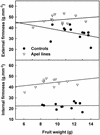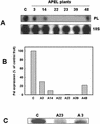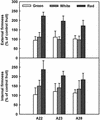Manipulation of strawberry fruit softening by antisense expression of a pectate lyase gene
- PMID: 11842178
- PMCID: PMC148936
- DOI: 10.1104/pp.010671
Manipulation of strawberry fruit softening by antisense expression of a pectate lyase gene
Abstract
Strawberry (Fragaria x ananassa, Duch., cv Chandler) is a soft fruit with a short postharvest life, mainly due to a rapid lost of firm texture. To control the strawberry fruit softening, we obtained transgenic plants that incorporate an antisense sequence of a strawberry pectate lyase gene under the control of the 35S promoter. Forty-one independent transgenic lines (Apel lines) were obtained, propagated in the greenhouse for agronomical analysis, and compared with control plants, non-transformed plants, and transgenic lines transformed with the pGUSINT plasmid. Total yield was significantly reduced in 33 of the 41 Apel lines. At the stage of full ripen, no differences in color, size, shape, and weight were observed between Apel and control fruit. However, in most of the Apel lines, ripened fruits were significantly firmer than controls. Six Apel lines were selected for further analysis. In all these lines, the pectate lyase gene expression in ripened fruit was 30% lower than in control, being totally suppressed in three of them. Cell wall material isolated from ripened Apel fruit showed a lower degree of in vitro swelling and a lower amount of ionically bound pectins than control fruit. An analysis of firmness at three different stages of fruit development (green, white, and red) showed that the highest reduction of softening in Apel fruit occurred during the transition from the white to the red stage. The postharvest softening of Apel fruit was also diminished. Our results indicate that pectate lyase gene is an excellent candidate for biotechnological improvement of fruit softening in strawberry.
Figures





References
-
- Abeles FB, Takeda F. Cellulase activity and ethylene in ripening strawberry and apple fruits. Sci Hortic. 1990;42:269–275.
-
- Barceló M, El-Mansouri I, Mercado JA, Quesada MA, Pliego-Alfaro F. Regeneration and transformation via Agrobacterium tumefaciensof the strawberry cultivar Chandler. Plant Cell Tissue Organ Cult. 1998;54:29–36.
-
- Barnes MF, Patchett BJ. Cell wall degrading enzymes and the softening of senescent strawberry fruit. J Food Sci. 1976;41:1392–1395.
-
- Blumenkrantz N, Asboe-Hansen G. New method for quantitative determination of uronic acids. Anal Biochem. 1973;54:484–489. - PubMed
-
- Bourne MC. Texture of temperate fruits. J Texture Stud. 1979;10:25–44.
Publication types
MeSH terms
Substances
LinkOut - more resources
Full Text Sources
Other Literature Sources

